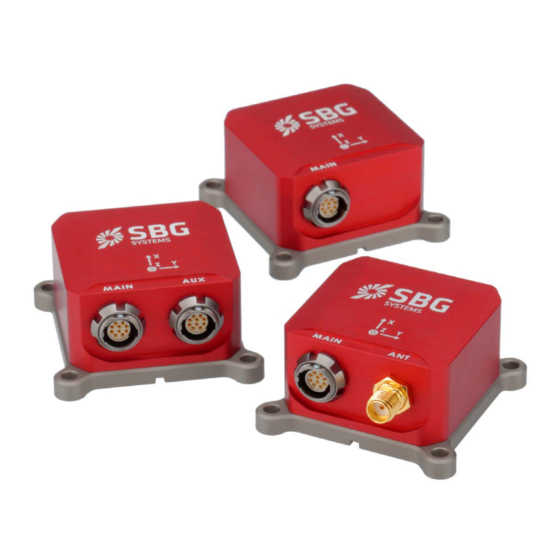Summary of Contents for SBG Systems Ellipse AHRS
- Page 1 Ellipse AHRS & INS Use in marine applications Operating handbook Document ELLIPSEOHSEA Support EMEA +33 1 80 88 43 70 Revision Jun 30, 2020 support@sbg-systems.com Americas: +1 (657) 549-5807 support@sbg-systems.com...
-
Page 2: Mechanical Installation
Ellipse – Operating Handbook ELLIPSEOHSEA This operating handbook explains how to install and setup an Ellipse in marine applications such as ship, ASV, ROV, or AUV. Mechanical installation is explained as well as software configuration and magnetic calibration. We recommend using the sbgCenter to configure the products, but this is also possible by using our sbgECom C library. - Page 3 Ellipse – Operating Handbook ELLIPSEOHSEA Magnetic environment If magnetometers are used for heading observation, user should also consider the magnetic environment. The Ellipse magnetometers require for good operation a clean magnetic field. The sensor should be placed away from any magnetic interference such as: DC motors, radios, strobe lights, power supplies etc.
- Page 4 Ellipse – Operating Handbook ELLIPSEOHSEA Dual GPS Antenna Placement Dual antenna systems installation will require special care in order to obtain optimal performance: Same antenna type, same cables with identical lengths must be used for both ● antennas. Both antennas must be turned the same way (connectors oriented in same direction) ●...
-
Page 5: Software Configuration
Ellipse – Operating Handbook ELLIPSEOHSEA Software configuration All Ellipse configuration is done through the sbgCenter interface, or using low level communication protocol. Note: At the first access, the Ellipse will have its default configuration. This data output configuration should be used it you want to send logs to Support. Don't hesitate to contact the Support Team for help. - Page 6 Ellipse – Operating Handbook ELLIPSEOHSEA Alignment and lever arms Here you can configure the alignment of the device and its lever arm in regard to the center of rotation of the ship. On the alignment settings you only need to set up the first two axis, then the third one will be automatically computed.
- Page 7 Ellipse – Operating Handbook ELLIPSEOHSEA Assignment GNSS Receiver assignment Here it is possible to select the serial port to receive the GNSS Receiver data, and select the input Synchronization as well. The Ellipse N and D GNSS are automatically set to “Internal” by default to select the on-board GNSS Receiver.
- Page 8 Ellipse – Operating Handbook ELLIPSEOHSEA Aiding GNSS Configuration Please check following point at the GPS configuration level: Choose this parameter depending on the GPS you are using (NMEA, Ublox, Novatel, Septentrio) Set up the lever arm of the GPS depending on its position on the ship (GNSS Antenna placement).
- Page 9 Ellipse – Operating Handbook ELLIPSEOHSEA Magnetic calibration in marine applications When magnetometers are used as heading reference, a magnetic calibration is mandatory for normal sensor operation. Different calibration methods are provided, depending on accuracy or ease of use requirement. Large ship calibration In case the boat is a heavy ship and it is not possible to move it by hand, it will be necessary to calibrate the magnetometers while cruising.






Need help?
Do you have a question about the Ellipse AHRS and is the answer not in the manual?
Questions and answers